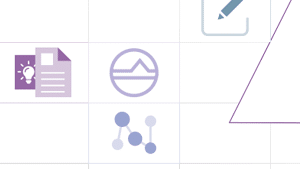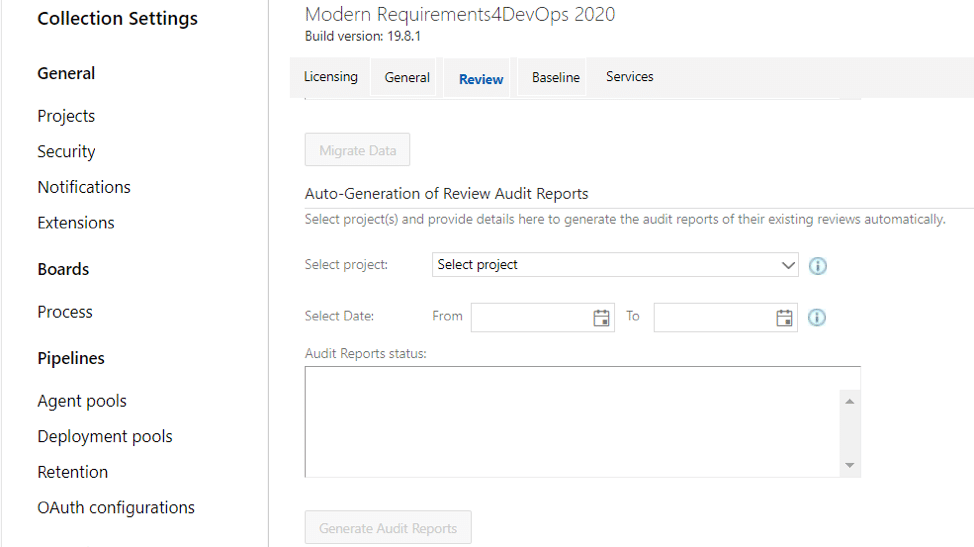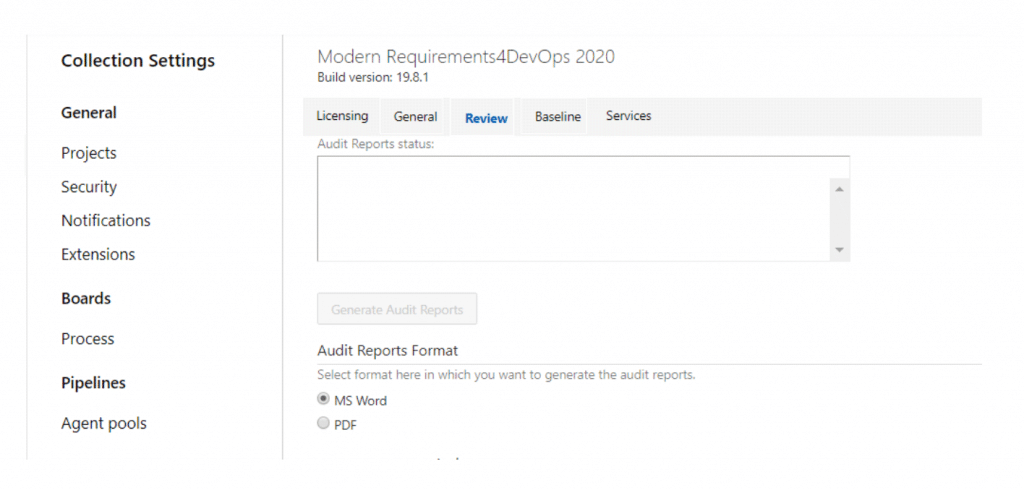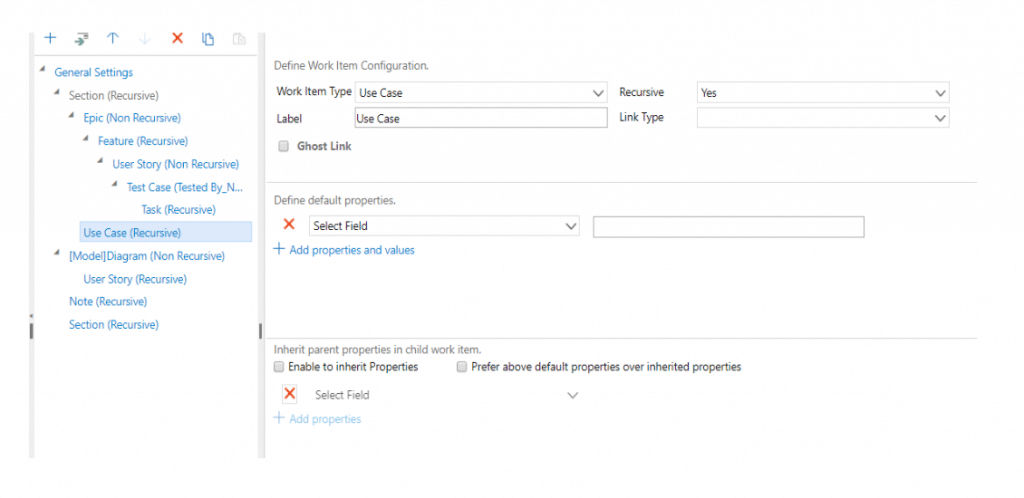In this blog we are going to share a few highlights made to some of our modules and some tool enhancements within Modern Requirements, for your convenience.
Continue readingNow Released: Modern Requirements4DevOps 2020
Now Released: Modern Requirements4DevOps 2020
Details of Modern Requirements4DevOps 2020's Core Enhancements!

User friendly, short cycle times, ability to author requirements online, compliance reporting, and reduced development rework. These are just a few of the phrases that have been used by our customers to describe the aptitude of several modules within the Modern Requirements4DevOps application. New features and enhancements have been made to the modules with our 2020 release.
Here we will share a few highlights made to a few of our modules within Modern Requirements and some tool enhancements for your convenience. Modules that we will be outlining are:
- Rights Management
- Review Enhancements
- Smart Docs Enhancements
- Smart Reports Enhancements
- Baseline Enhancements
- MatCal (New!)
1. Rights Management: You asked, and we listened. You can now manage User Access. A user (must have collection/project Admin) rights can now manage user access to both modules of Modern Requirements4DevOps, and the features within each module. Setting these permissions is as easy as one-two-three… steps to set permissions:
- Access your project
- Go to Project Settings
- Scroll down to Extension > click on Modern Requirements4DevOps
This is what you will see:
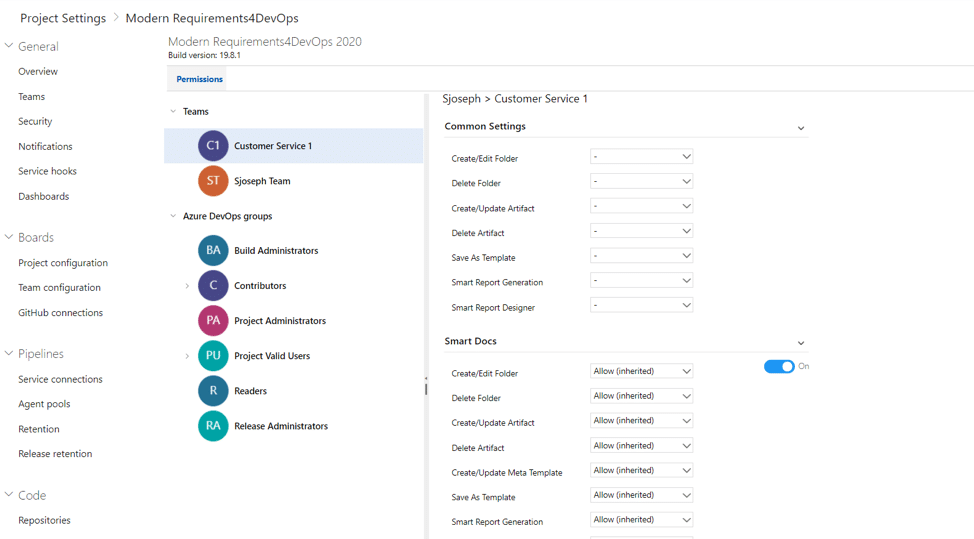
From this screen, you will be able to set the *Group and/or *Team permissions (located on the left panel). There are two ways to set permissions, you can either do it in the “*Common Settings” or within “*Modern Requirements4DevOps Modules” individually (located on the right panel of the permissions tab). Here you can set permissions for the features of each modules.
The permission options available are:
- Create/Edit Folder
- Delete Folder
- Create/Update Artifact
- Delete Artifact
- Create/Update Meta Template
- Save as Template
- Smart Reporting
- Report Designer
Currently, Rights Management is supported for three modules: Smart Docs, Baseline and Reporting.
Rights Management Video
For further details on what’s new in Rights Management and its functionality please refer to the video.
2. Review Enhancements: The Review module allows you to communicate, review, and approve within the project environment and facilitate change when necessary. Enhancements have been made to Review module. Here is a list of a few of the new features:
- Read-only rights to non-participants of review
- Auto Bulk generation of review Audit Reports
- Audit Reports Format- Word/PDF
Read-only rights to non-participants of review: With this enhancement you now have the ability to configure rights for non-participants where they can view review details in read-only mode.
Non-participants users: Users that are neither the approver nor the reviewer.
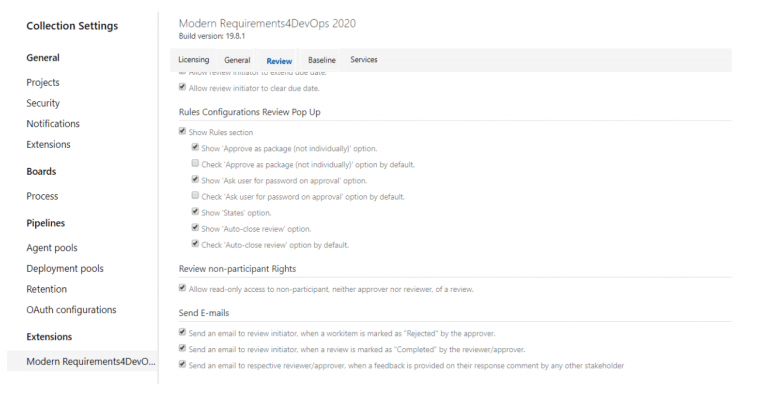
Auto Bulk generation of review Audit Reports: This enhancement will allow you to generate Audit Reports of all reviews in a project at once in bulk or project wise from admin panel.
You can select project(s) and provide details here to generate the audit reports of their existing reviews automatically
Audit Reports Format – Word/PDF: System now gives you the ability to select format in which you want to generate the audit reports in. You can select either word or PDF version.
The purpose of Approval Audit report is to provide details of all the work items in a Review. It provides complete status regarding who has approved or rejected the review work items along with the comments and decisions
- Go to Admin/Collections Setting
- Scroll down to Extensions
- Choose Modern Requirements4DevOps2020
- Go to Review tab (look for the option you want to make the changes to)
Review Management Video
For further details on what’s new in Review Management and its functionality please refer to the video.
3. Smart Docs Enhancements: Smart Docs is a tool that bridges the gap between document and information management by authoring requirements in a document view online. New features have been added to Smart Docs, some of the highlights are as follows:
- Full Screen Support
- Right Panel UI Update
- Inherit Parent Properties Update
Full Screen Support: In order to have a better user experience and larger display you can now view Smart Docs in full screen mode. Which means a better view when building your online requirement documents.
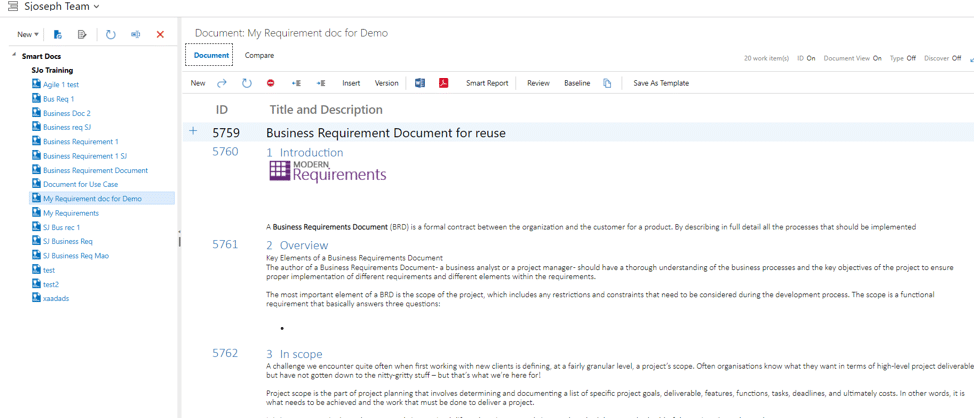
Right Panel UI Update:
- For your convenience a cross icon has been added to the right panel UI. Which means you can now close the right panel directly through the panel itself.
- If this was not enough, we have also added expand/collapse capability to the “*find” query area for a better user experience.
- Also, in order to provide more space to show more work items, “Add child/sibling” and “Select all/ unselect all” buttons have been removed. Remember, you can still drag and drop your work items into the document section.
Inherit Parent Properties Update: This is an update with which by default, the check box to inherit parent work item properties in child work item will be shown ‘un-checked’.
Note: If no properties are selected from the drop-down option, then no properties will be inherited in the child work item.
Smart Docs Video
For further details on what’s new in Smart Docs and its functionality please refer to the video.
4. Smart Reports Enhancements: Smart Report enables users to format their reports according to the work items structure. It is accessible from many of the ADO and Modern Requirements4DevOps modules. Here is a list of some of the tool enhancements made to Smart Report module:
- Upload macro-enabled Word template
- Retain selection of last uploaded Word template
- Retain selection of last Smart Part
Upload macro-enabled Word template: Smart Report now allows you to upload and execute Macro-Enabled Word document (.docm) as well as Macro-Enabled Word Template (.dotm) files in Smart Report through “Upload word template”. It will make your user-friendly option of uploading word templates even more of a breeze.
Retain selection of last uploaded Word template: Guess what… Smart rReport has now become smarter, it will now retain the last selection that you made while uploading your word template.

Retain selection of last Smart Part: Well we did not stop at remembering the last selection for the word template… Enhancements have been made where the system will now also retain the selection of your last Smart Report Part as well. Well, it is winning all the way for report creators.
Smart Report Video
For further details on what’s new in Smart Reports and its functionality please refer to the video.
5. Baseline Enhancements: Baseline allows you to take a snapshot of your requirements at a point in time to allow better control and track changes. Here is how it will make your work experience even better:
- Retain work item selection on tab switching
- Comparison ID on Baseline comparison
Retain work item selection on tab switching: System will now remember the last work item selection when navigating between different tabs within baseline. What does that mean? Well, while working with a baseline (specially with a large one), navigate to Compare or Detail tab and back to View tab if you have forgotten which work item you were working with… Worry no more, because the system will remember it for you.
Comparison ID on Baseline comparison: Enhancements have been made so you can now view work item revisions only where work items exist within both baselines being compared. For example: if a work item doesn’t exist in one of the baselines, no revision ID will be displayed, instead “-” will be displayed in Rev.ID or Comp.Rev.ID column. This rule will also be applied in the difference report.
Baseline Video
For further details on what’s new in Baseline and its functionality please refer to the video.
6. MatCal (New): A new feature has been introduced to Modern Requirements to perform mathematical and logical expressions. Sounds exciting? Well, we are excited about it. Here’s why:
- It will allow you to have work items field(s) automatically calculated based on input of other field(s) of the same work item(s)
- It can be applied to any work item fields, including numerical, Boolean, and textual types of work item fields
What you need to do: Provide your formulas to a Modern Requirements Customer Success team member and we will be happy to configure it on your behalf.
MatCal Video
For further details on MatCal and its functionality please refer to the video.
We are excited to announce that Modern Requirements4DevOps 2020 is now available for download!
- Already a Modern Requirements4DevOps user? Click here to download now!
- Not currently using Modern Requirements? Try for free!
Modern Requirements 2019: Update 2
Modern Requirements4DevOps 2019 - Update 2
Welcome to Modern Requirements4DevOps 2019 Update 2! Many improvements and enhancements have been added in this release. The following is an annotated version of the release notes to help guide users through the update to Modern Requirements4DevOps.
General
A completely new tool has been added to Modern Requirements to assist you in your project traceability and management needs. The MR Artifact Tool!
The MR Artifact Tool is accessible from the context menu of any work item. This tool lists all Modern Requirements artifacts that the work item is associated with! Now users can now quickly access which Modern Requirements artifacts are utilizing the work item selected.

This tool currently can trace work items that are contained in Smart Docs, Reviews, and Baselines.

The Compare Tool, used for direct comparisons between work item revisions has, for lack of a better work, been revised!
RevisionIDs are now further demarcated by new properties. The new properties are Last Approved and Last reviewed. These properties will apply themselves to revisions of work items that have undergone review during their life cycle.
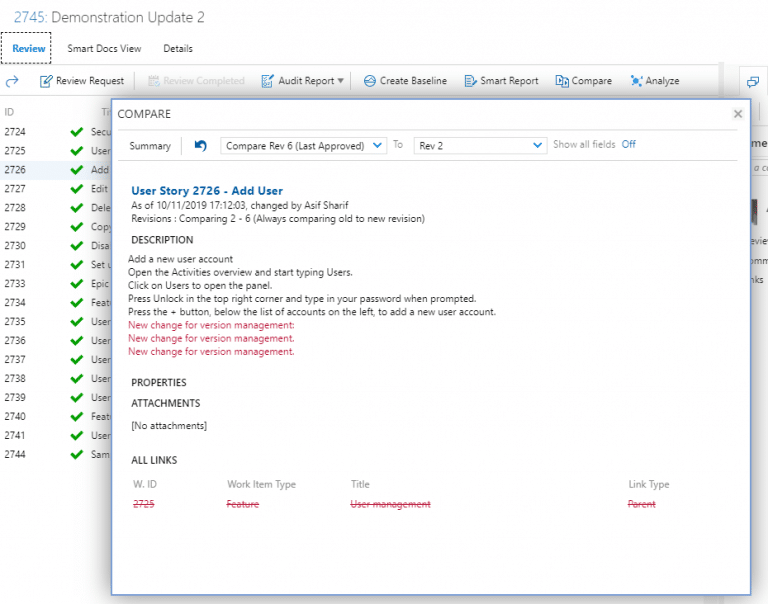
These properties will be displayed next to the RevisionID in the dropdown menu of the Compare Tool.
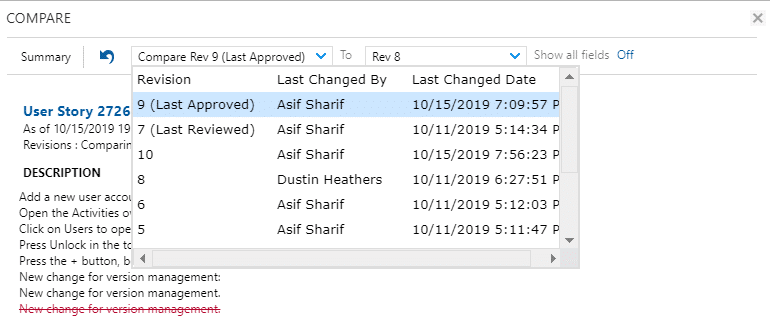
When using the Compare Tool, the tool will automatically populate a default revision into the dropdown menu. When a dropdown menu is opened, the Last Approved and Last Reviewed work items will be shown respectively at the top of the list. They will be followed by the remaining revisions shown in descending order (newest to oldest).
When the Compare Tool is invoked, the left dropdown menu will always display the relevant revision of the work item. When opened from the Backlog, this field will be populated with the latest revision. When launched from a Review, this field will default to the revision of the work item that was included in the review. If accessed from a Baseline, this field will display the revision of the work item as it was at the time the baseline was created.
The right dropdown is the compare revision field. If the work item has taken part in a review, this field will default to the Last Approved revision.
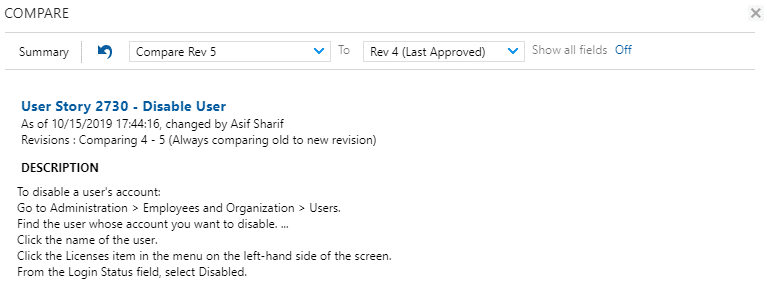
If an approved revision does not exist, this field will default to the Last Reviewed revision.
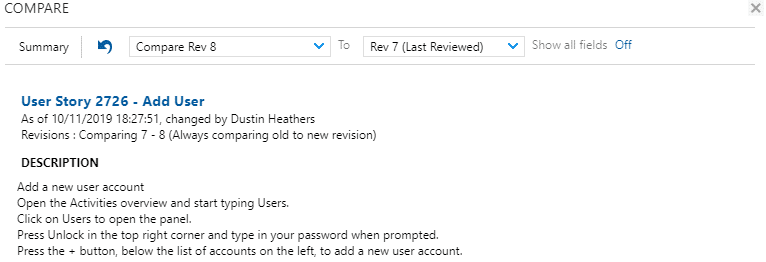
If the left dropdown defaults to the latest approved revision of a work item, the right dropdown will remain empty.
The Compare Tool can be accessed from a newly created work item. However, without any revisions the right dropdown will again be empty.
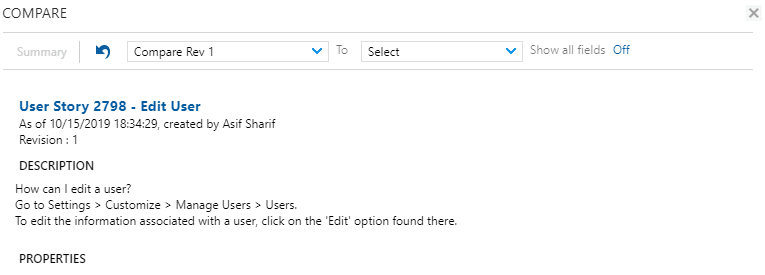
When invoking the Compare Tool from within the Compare Baseline tab, the tool functions differently. The comparison is no longer automatic as the user is manually comparing the work item between two baselines. The dropdowns within the tool will instead default to the revision of the work item included in each compared baseline.
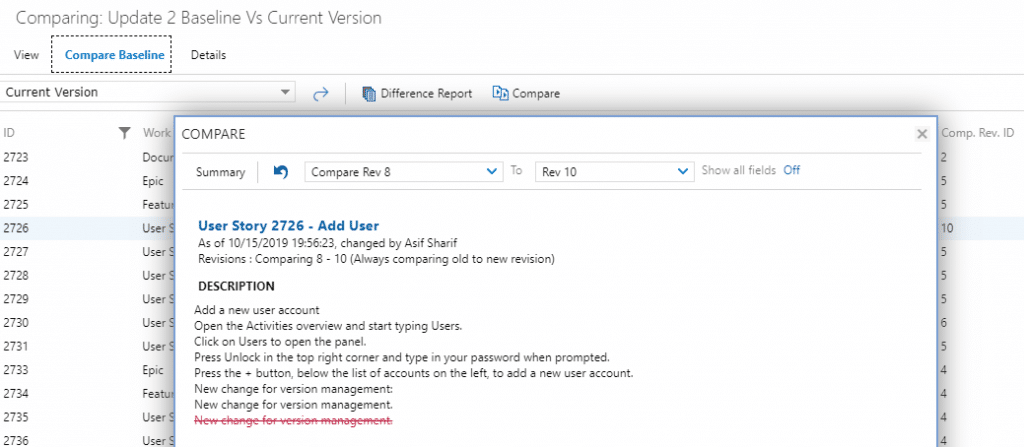
While using the Compare Tool, the user can interact with either dropdown and make any comparison between revisions.
Smart Docs
Smart Docs has increased in functionality with the addition of three new features…
Child work items created in Smart Docs can now automatically inherit properties of their parent!
Smart Docs’ Meta Template Designer now allows users to configure work items with inheritable fields. When creating a sub/child work item on-the-fly from a parent node, values from configured fields can be inherited from the parent. This rule is not applied when inserting existing work items.

Smart Editor has also introduced a new feature with read-only fields.
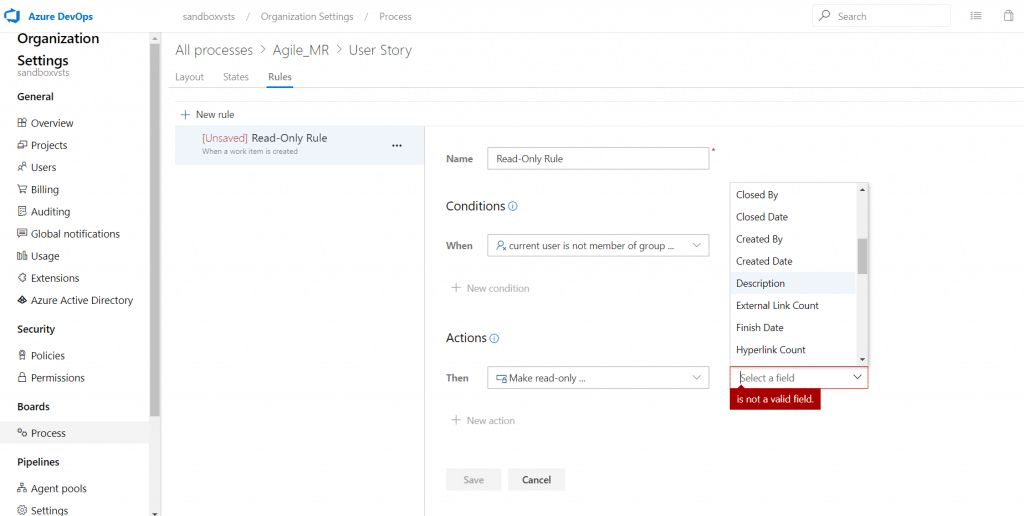
Individual fields can be defined as read-only within the process template. Smart Editor will also treat these fields as read-only.
Modern Requirements Stakeholder interaction with Smart Docs has further improved with the introduction of the option to open work item. Previously stakeholders could not open work items – now they can!
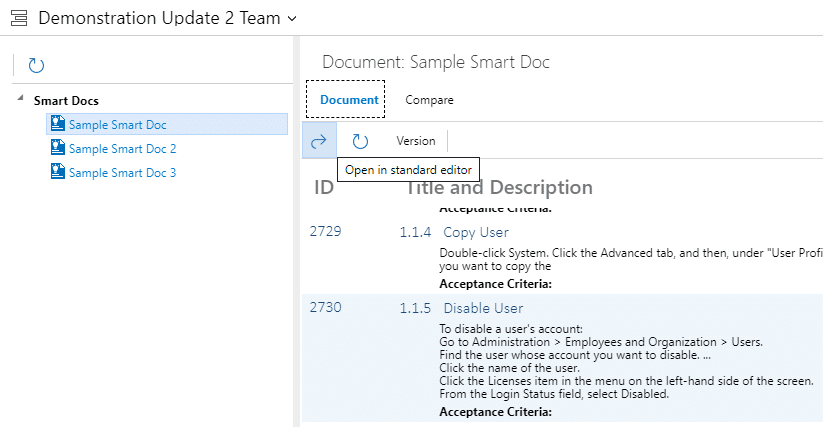
When enabled, Stakeholders invited to the project will be able to open items in Azure DevOps’ standard editor.
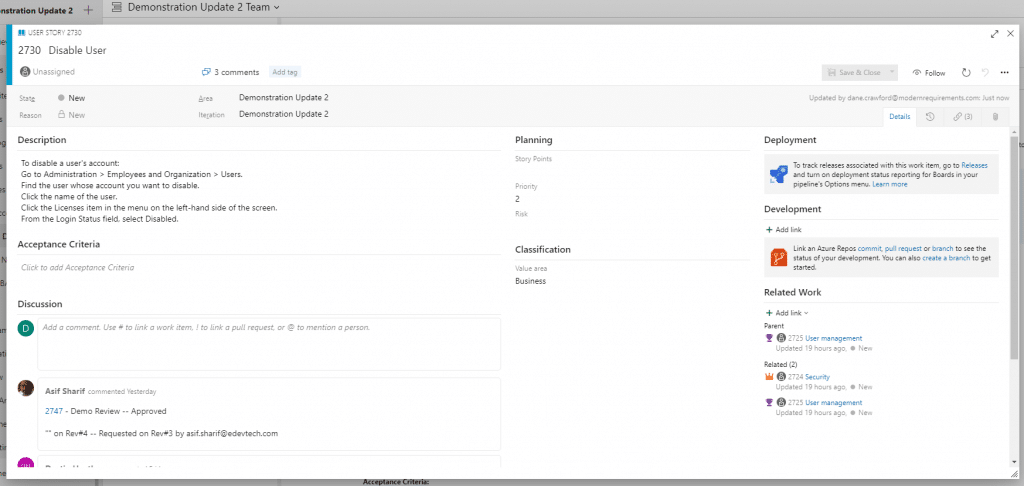
Stakeholders can access this feature from both the Document and Compare tabs of Smart Docs.
Additional enhancements have been made to the current features of the Smart Docs module.
The Meta Template Designer now gives users the ability to update saved Document Templates. Previously, this functionality only applied to meta templates; now document templates can also be updated!
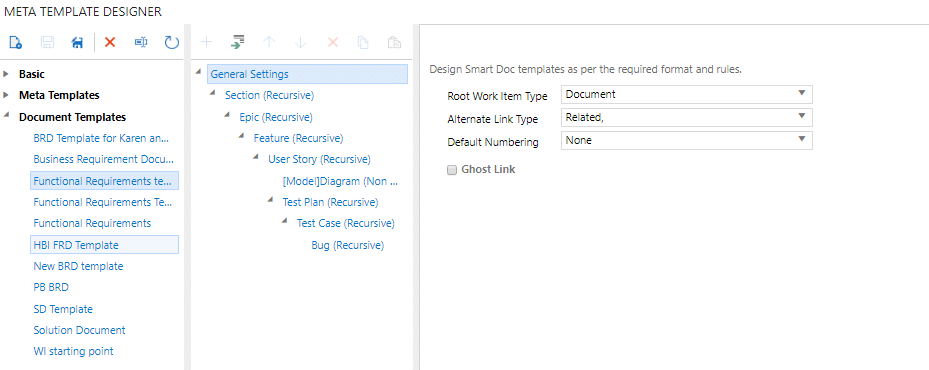
This provides users with the ability to make on-the-fly changes to any of their document templates.
Functionality includes:
- Change work item hierarchy
- Rename Templates
- Delete Templates
- Clone templates; create a unique version of template to edit
Changes made to Document Templates can be applied to all Smart Docs using the template. After changes are made, a user just needs to use the “Update all Templates” feature in the Smart Docs toolbar.
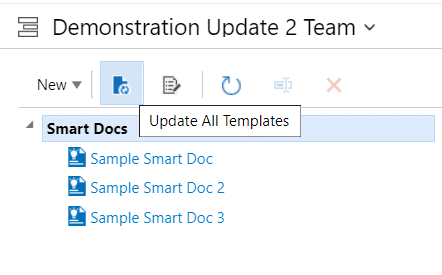
A major change has been made to the aesthetic form of Smart Docs.
Both text and image wrapping have been improved in Smart Docs as all included data will now properly be wrapped to the successive line.
This is a purely aesthetic change. However, this change should greatly improve the readability and the way an individual will visually consume the output document.
Smart Docs’ title, HTML fields, large images, and tables will all benefit from this improvement.
Review Management
Some very functional additions have also been made to the Review Management module.
As a review initiator, you will now be able to Submit Comments without needing to be a reviewer – a review initiator is a reviewer by default.
Two new types of Audit Reports have been added to the Review Management module.

Approval Audit Report:
Report includes complete details of approval actions applied to the work items in the review
- Details will include if a work item was approved or rejected and by which user profile, response comment, review action, additional comments, and added linked work items.
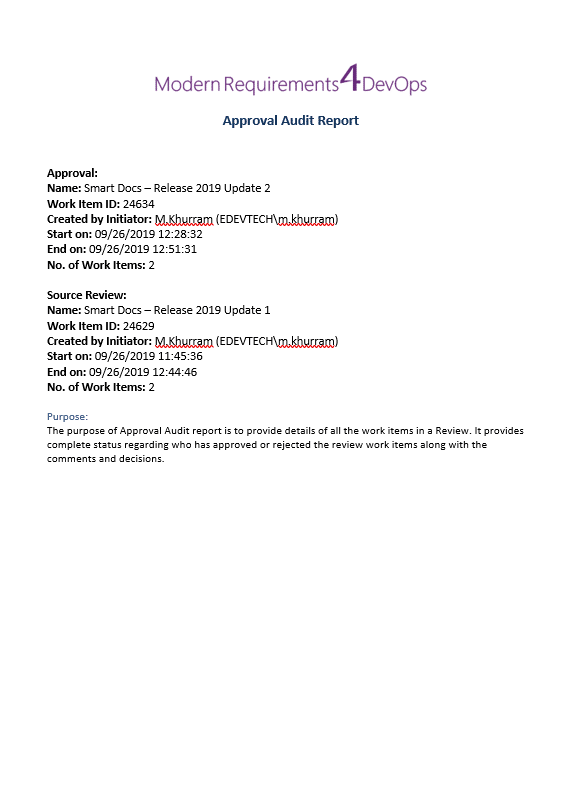
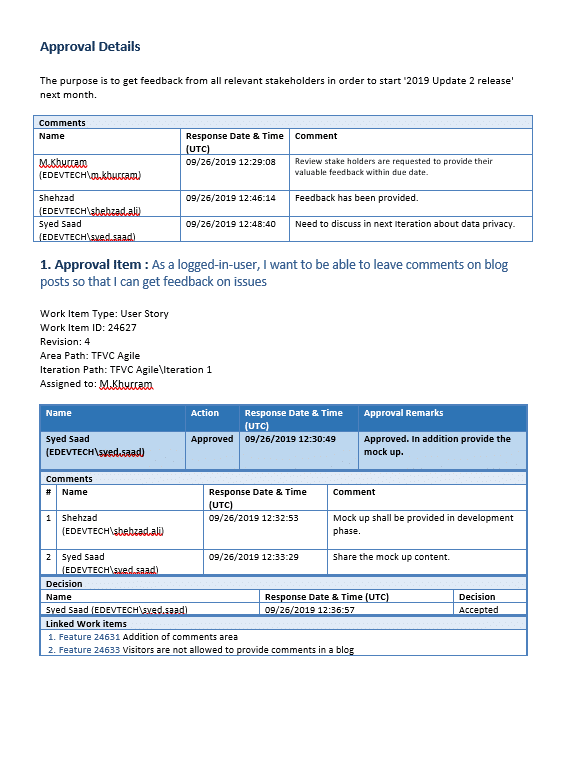
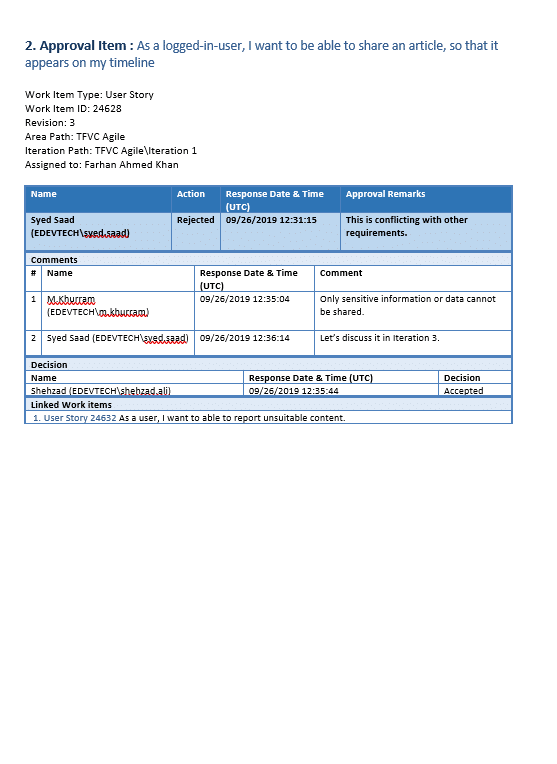
Review Results Report:
Report Includes the complete details of review actions applied to the work items in the review
- Details will include if a work item is reviewed and by which user profile, response comment, review action, additional comments, and added linked work items.
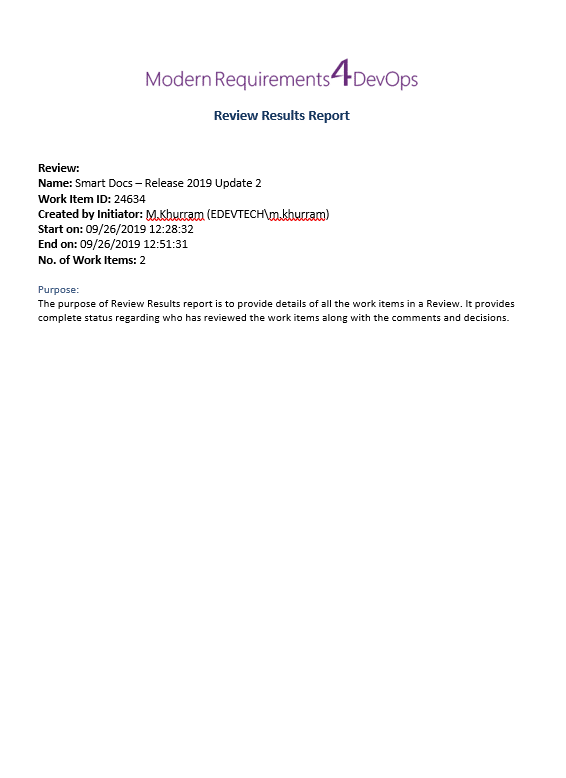
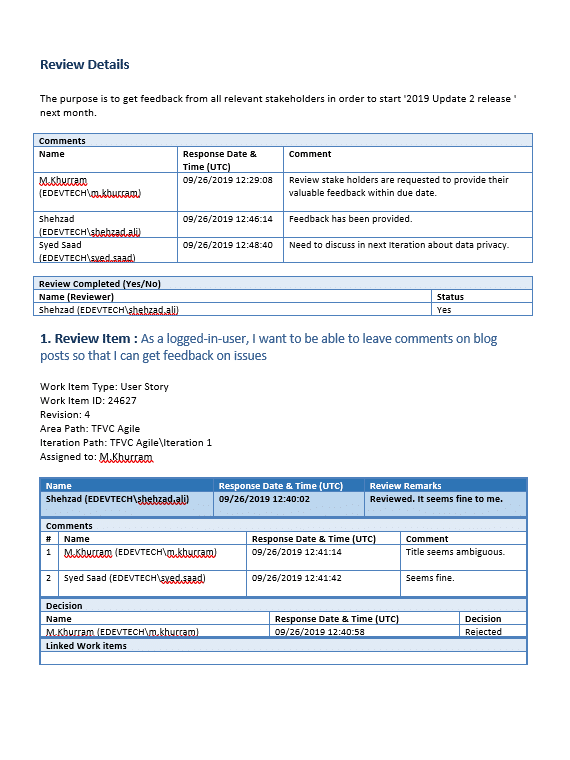
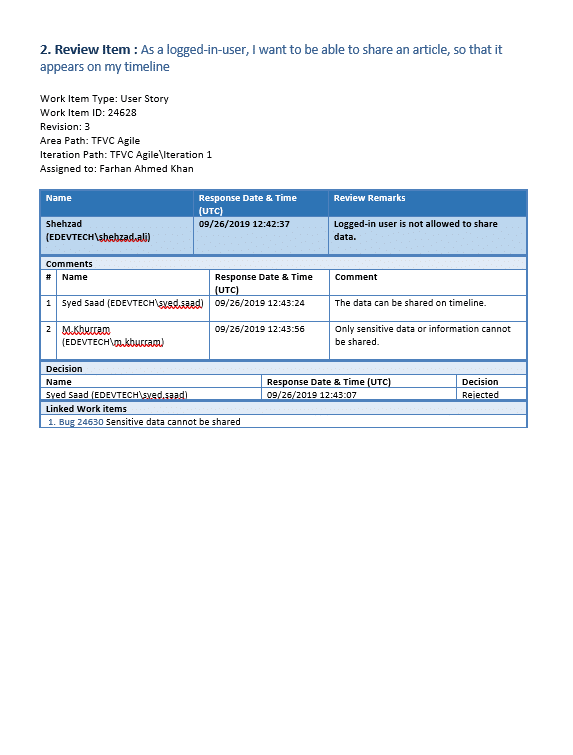
It should be noted that the existing Review Audit Report will be retitled as Legacy Audit Report.
Users still have access to Legacy Audit Report option.
The Review Management module has received several enhancements to its core functionality.
The way Modern Requirements handles Review metadata has been completely overhauled. When creating a review, the corresponding metadata will now be saved in your repo (source control).
Review metadata was previously stored within the HTML field of a Feedback Request work item.
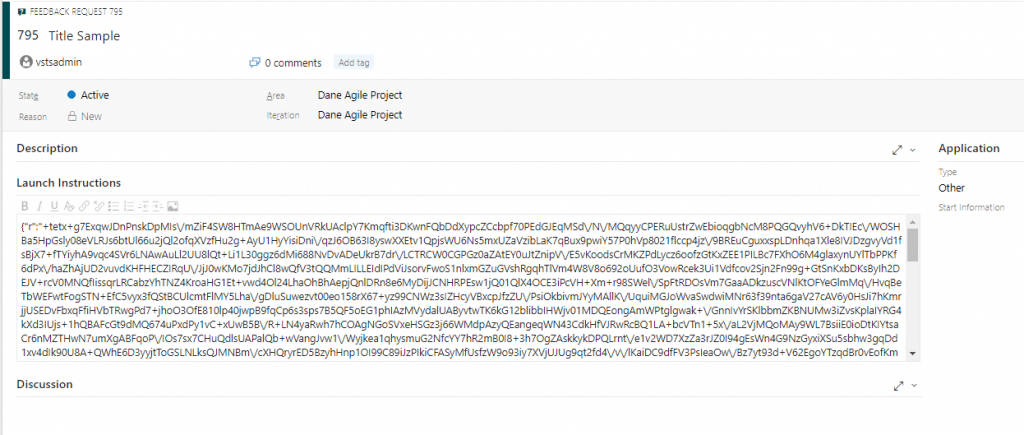
Update 2 has also brought changes to the operational process of Review Management.
The previous review creation process was slow and link heavy; three links were created for each work item included in a review.
In Update 2, when a review is created, links will no longer be created between the Feedback Requests and work items included in the review.
Additionally, a Feedback Response work item will no longer be created by the system when a user provides a review response (approval/submit review).
The new process is more efficient and link-free to mitigate Azure DevOps’ restriction of 1000 links/work item limit.
Additionally, automation has been improved when completing common actions within reviews.
When using the Link work item feature to link a work item to an approval or rejection, the link will be made directly to the work item the user is currently reviewing.
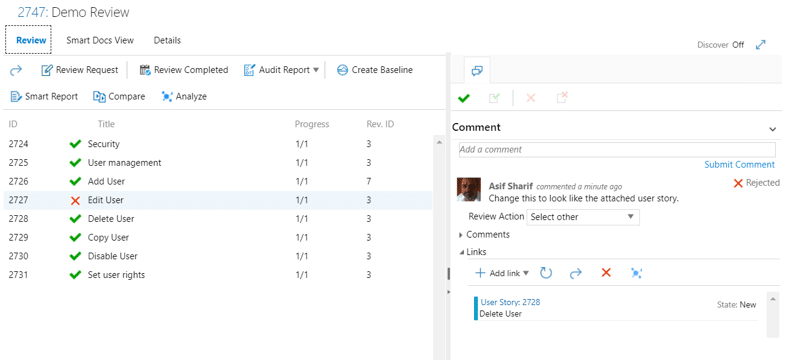
Comments provided in the Details tab will be automatically added to the Feedback Request work item along with the profile information of the comment poster.


Upon the completion of a review, a comment will be added to the Feedback Request work item along with the profile information of the participant.

When reviews have been closed, no further action can be taken for approval and commenting. This will prevent review stakeholders from being able to add additional comments or link work items to the closed review.
Changes have also been made to update the UI of the Review Request popup form.
- When initiating a Review from Smart Docs, work item section will no longer be shown
- When previewing a Review, the list of selected work items will no longer be shown
- The body of an email generated during a Review will no longer contain the list of selected work items
Baseline
The Baseline module has improved its capabilities with the addition of new features to improve trace and manage your work items.
When comparing Baselines, users can now configure which individual link types trigger a change indicator. Previously, users only had the option to disable the trigger or have it applied for all link types. This configuration can be found within the Admin Panel.

Difference Reports have been enhanced to only show fields that have been configured as trigger for change indicators. Previously, the Compare Tool UI and the Difference Reports were not in sync.
With the inclusion of tracking link type changes between baselines, Difference Reports will include the ability to report on link type changes.
The Copy/Reuse Baseline Tool has also received some boost in functionality.
The system will automatically copy the area/iteration path of the source project and set it to the copied work items if the identical values exist in the target project.
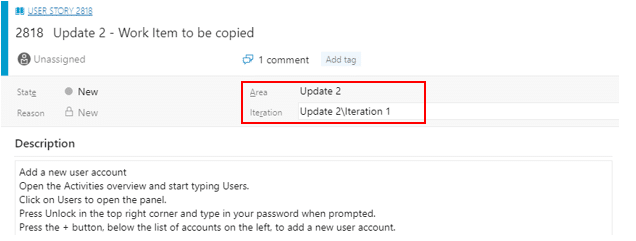
As seen In this example, as the work item is copied, the work item’s iteration path is copied from the source project and set in the target.
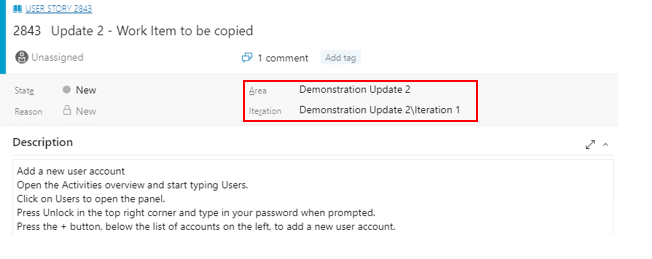
Smart Report
As with previous iterations of the Smart Report Tool, users can upload and apply Word templates to their reports. Update 2 introduces the ability to Inherit Word Styling when Smart Reports are exported to Microsoft Word and a Word template is applied.
From the template, Smart Reports will inherit styling for headings, font size, underlined or bold text, font color, indentation, and alignment.
This option can be found in the “Style Sheet” dropdown menu.
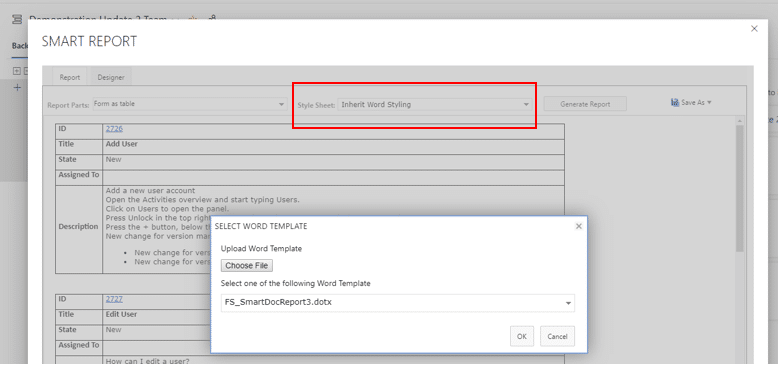
Admin Panel
Improvements have also been made regarding how Modern Requirements data is handled.
Modern Requirements data will now automatically sync to Azure DevOps Server (TFS) source control for single-Sign on build deployments.
To use this capability, add a Collection-level user’s credentials to the General tab of the Modern Requirement4DevOps Admin Panel.

If credentials have not been provided, the user will be prompted with a notification message.
Modern Requirements data will sync with both GIT and Team Foundation Version Control.
Scalability
Modern Requirements recognizes that our client’s projects will scale, and their requirements management software should scale with them.
Modern Requirements4DevOps throughput performance has been greatly optimized. Update 2 introduces the ability to support large sets of data in work item heavy modules. Large data support has been added to Review Management, Baseline, and Smart Report.
Reviews and Smart Reports can now be created with a maximum of 10,000 work items.
Users can now create Baselines that include up to 100,000 work items.
Additional improvements in throughput to features of Baseline include:
Copy work items
- 5,000 work items in Azure DevOps Server
- 2,000 work items in Azure DevOps Service
Difference Reports
- 10,000 work items in Azure DevOps Server
- 3,000 work items in Azure DevOps Service
Rollback work items
- Can perform this operation on 10,000 work items
Completing operations using large sets of data can sometimes be time consuming. Modern Requirements recognizes that your time is valuable and has already implemented features to improve efficiency.
Time consuming operations no longer slow you down. These operations are now completed in the background and provide users the option of being notified by email when completed.
This feature has been integrated into the Review Management module and is available when conducting the Approve/Reject All feature on large sets of work items. The system will automatically identify when the operation will take more than one minute and notify the user.
Smart Report is also supported by this feature. If generating the Smart Report does not instantly occur, a background process will be initiated. Regarding Smart Report, notification email’s will contain links that enable the user to save their output report to Word or PDF.
Bug Fixes
Functionality and user experience are core elements in Modern Requirements design philosophy.
Several bugs were address and fixed with the release of Update 2. To see a full list of bug fixes or want to read the full release notes please click here.

